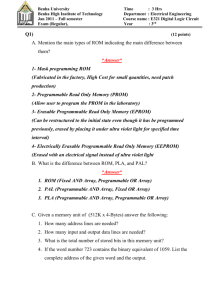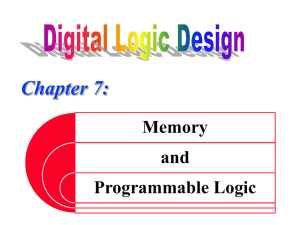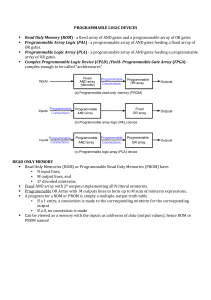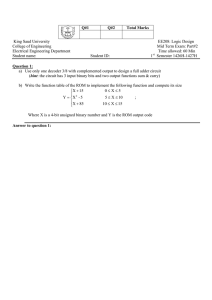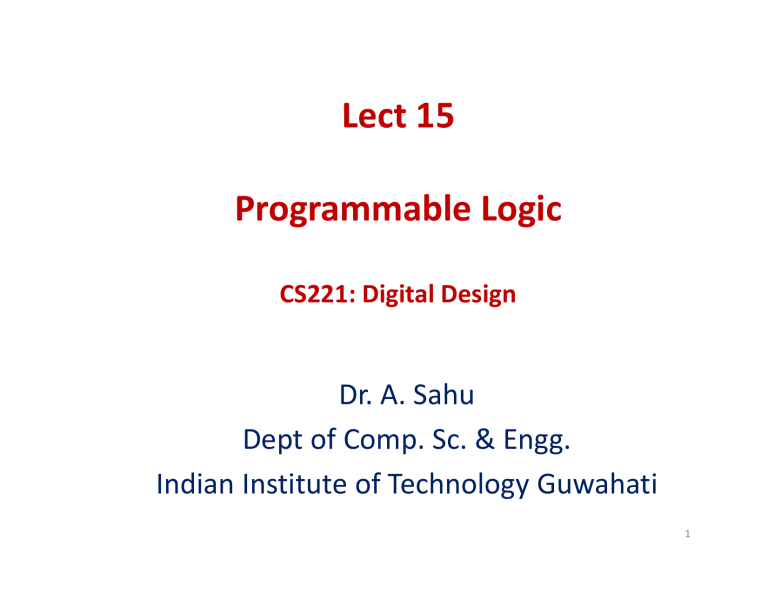
Lect 15 Programmable Logic CS221: Digital Design Dr. A. Sahu Dept of Comp. Sc. & Engg. Indian Institute of Technology Guwahati 1 Outline • Programmable Logic • PAL, PAL PLA PLA, • Memory –ROM, PROM, EPROM, EEPROM –SRAM SRAM : Memory Cell • CPLD, CLB, FPGA • FPGA/ASIC Design Flow • HDL Programming : Verilog HDL 2 Programmable Logic Devices Programmable Via Control : Adder/Substractor / • C= B‐A=B+(‐A)=B+ (Ab+1), Ab is complement of A • D is control bit: D=0/1 operation is add/sub A Result B ALU Operation 4 Programmable Via Select: ALU • Arithmetic and Logic Unit • Add/Sub/OR/AND/Shift… R=0 A R>0 Co R B Control: What to do ? if if if if if if if if Control=0 R =A +B Control=1 R =A ‐ B Control=2 R =NOT A Control=3 R =A AND B Control=4 R =A OR B Control=5 R =A XOR B Control=6 R = (A<B)?0:A Control=7 R =A SHFT B 5 Programmable Logic Devices Programmable Logic Organization • Pre‐fabricated building block of many AND/OR gates (or NOR, NAND) • "Personalized" by making or breaking connections among the gates Inputs Dense Array of AND gates Product terms Dense Array of OR Gates Outputs Programmable Array Block Diagram for Sum of Products Form Basic Programmable Logic Organizations • Depending on which of the AND/OR logic arrays is programmable, we have three basic organizations ORGANIZATION AND ARRAY OR ARRAY PAL PROG. FIXED PROM FIXED PROG. PLA PROG. PROG. PLA Logic Implementation Key to Success: Shared Product Terms Example: Equations F0 = A + B’ C’ F1 = A C ‘ + A B F2 = B ‘C’ + A B F3 = B ‘C + A Personality Matrix Product Inputs Outputs t erm A B C F0 F 1 F 2 AB 1 1 ‐ 0 1 1 B’ C ‐ 0 1 0 0 0 A C’ 1 ‐ 0 0 1 0 B’ C’ ‐ 0 0 1 0 1 A 1 ‐ ‐ 1 0 0 Input Side: 1 = asserted in term 0 = negated in term ‐ = does not participate Output Side: 1 = term connected to output 0 = no connection to output F3 0 1 Reuse of 0 0 terms 1 PLA Logic Implementation Example l Continued i d ‐ Unprogrammed d device d i A B C All possible connections are available b f before programming i F0 F1 F2 F3 PLA Logic Implementation Example Continued ‐ Programmed part A B C Unwanted connections are "blown" AB B’C AC’’ B’C’ A Note: some array structures work by making connections rather than breaking them F0 F1 F2 F3 PLA Logic Implementation Alternative representation Un‐programmed device Sh t h d notation Short‐hand t ti so we don't d 't have h t to draw all the wires! X at junction indicates a connection PLA Logic Implementation Notation for implementing F0 = A B + A’ B’ F1 = CD CD’ + C C’D D A B C Programmed device D AB A’B’ CD’ C’D AB+A’B’ CD’+C’D PLA Logic Implementation Multiple functions of A, B, C : List of all product terms A B C Design Example Programmed device ABC A B C A’ B’ C’ A’B’C’ A’B’C A’BC’ AB’C’ ABC’ A’BC AB’C F1 = A B C F2 = A + B + C F3 = (A B C) C)’ F4 = (A + B + C)’ F5 = A ⊕ B ⊕ C F6 = (A ⊕ B ⊕ C)’ F1 F2 F3 F4 F5 F6 PLA Logic Implementation Another Example: Magnitude Comparator AB A AB A CD 00 00 1 01 0 11 0 10 0 CD 00 00 0 01 1 11 1 10 1 01 0 1 0 0 01 1 0 1 1 11 0 0 1 0 11 1 1 0 1 10 0 0 0 1 10 1 1 1 0 C D C B K‐map for NE B K‐map for EQ AB A AB A CD 00 00 0 01 0 11 0 10 0 CD 00 00 0 01 1 11 1 10 1 01 1 0 0 0 01 0 0 1 1 11 1 1 0 1 11 0 0 0 0 10 1 1 0 0 10 0 0 1 0 C B K‐map for L T D D C B K‐map for GT D PLA Logic Imp: Magnitude Comparator A B C D A’B’C’D’ A’BC’D A BC D ABCD AB’CD’ AC’ A’C B’D BD A’B’D B’CD ABC B’C’D’ EQ NE LT GT PALs and PLAs What is difference between Programmable Array Logic (PAL) and Programmable Logic Array (PLA)? PAL concept — implemented by Monolithic Memories AND array is programmable, OR array is fixed at fabrication A given column of the OR array has access to only a subset of the possible product terms PLA concept — Both AND and OR arrays are programmable PALs and PLAs • Of the two organizations the PLA is the most flexible – One PLA can implement a huge range of logic functions – BUT many pins; large package, higher cost • PALs are more restricted / you trade number of OR terms vs number of outputs – Many device variations needed – Each device is cheaper than a PLA Read‐Only Memory ROM ROM • Decoder : Produces minterms • Ors : Produce SOP’s A B C D S3 S2 S1 4:16 4 16 dec S0 Enb 0 1 2 3 4 5 6 7 8 9 10 11 12 13 14 15 A‘B’C’D’ A ‘B’C’D A‘B’CD’ A B CD A‘B’CD A‘BC’D’ A‘BC’D A‘BCD’ A BCD A‘ BCD A B’C’D’ A B’C’D AB’CD’ A B CD A B’CD A B C’D’ A B C’D AB A B C D’ AB C D F1 F2 F3 ROM • A decoder • A set of programmable OR’s A B C D7 D6 D5 D4 A2 D3 D2 A1 D1 A0 D0 X X X X X X F3 21 X F2 X X X F1 F0 ROM vs. PLA/PAL Inputs Fixed AND array (d (decoder) d ) Programmable Connections Programmable OR array Outputs (a) Programmable read-only memory (PROM) Inputs Programmable Programmable AND array Connections Fixed OR array Outputs (b) Programmable array logic (PAL) device Inputs Programmable Programmable AND array Connections Programmable Connections Programmable OR array (c) Programmable logic array (PLA) device 22 Outputs General Logic Implementation k • Given a 2 xn ROM, we can implement ANY combinational bi ti l circuit i it with ith att mostt k inputs and at most n outputs. • Why? k k – k‐to‐2 k to 2 decoder will generate all 2 possible minterms – Each h off the h OR gates must implement l a ∑m() – Each ∑m() can be programmed 23 Example • Find a ROM‐based circuit implementation for: – f(a,b,c) = a’b’ + abc – g(a,b,c) ( b ) = a’b’c’ ’b’ ’ + ab b + bc b – h(a,b,c) = a’b’ + c • Solution: – Express f(), g(), and h() in ∑m() format (use truth tables) – Program the ROM based on the 3 ∑m() ∑m()’ss 24 Example • There are 3 inputs and 3 outputs, thus we need a 8x3 ROM block. f = ∑m(0, 1, 7), g = ∑m(0, 3, 6, 7), h = ∑m(0, 1, 3, 5, 7) a b c 3-to-8 decoder 0 1 2 3 4 5 6 7 f 25 g h ROM as a Memory • Read Only Memories (ROM) or Programmable Read Only Memories (PROM) have: – N input lines, – M output lines lines, and – 2N decoded minterms. • Can be viewed as a memory with the inputs as addresses of data (output values), – hence ROM or PROM names! 26 Memories • Volatile: Random Access Memory (RAM) – SRAM "static" – DRAM "dynamic" • Non Non‐Volatile: Volatile: Read Only Memory (ROM): – Mask ROM "mask programmable" – EPROM "electrically electrically programmable" programmable – EEPROM “electrically erasable electrically p g programmable" – FLASH memory ‐ similar to EEPROM with programmer integrated on chip 27 ROM as Memory Read Example: For input (A2,A1,A0) = 011, output is (F0,F1,F2,F3 ) = 0010. •What are functions F3, F2 , F1 and F0 in terms of (A2, A1, A0)? • 8x4 ROM Address D0 D1 D2 D3 A2 D4 D5 A1 D6 A0 D7 A B C X X X 0 1 1 0 1 X 1 0 0 0 0 2 1 0 0 1 A[2:0] 3 0 0 1 0 F[3:0] 4 0 0 0 0 4 5 1 0 0 0 6 0 0 1 1 7 0 1 0 0 X X X X X F0 28 X F1 F2 3 F3 A[2:0] =A2A1A0 F[3:0]=F3F2F1F0 Design by ROM: Example • BCD to 7 Segment Display l Controller ll 29 ABCD a b c d e f g 0000 0001 0010 0011 0100 0101 0110 0111 1000 1001 1010 1011 1100 1101 1110 0111 1 0 1 1 0 1 1 1 1 1 X X X X X X 1 1 1 1 1 0 0 1 1 1 X X X X X X 1 0 1 1 0 1 1 0 1 0 X X X X X X 0 0 1 1 1 1 1 0 1 1 X X X X X X 1 1 0 1 1 1 1 1 1 1 X X X X X X 1 0 1 0 0 0 1 0 1 0 X X X X X X 1 0 0 0 1 1 1 0 1 1 X X X X X X a f b e c d g Memory Unit Read/Write Address Data to Read/Write M A R D e c o d e r Data Memory Unit n bits Memory cell 0 1 2 3 4 bit 1 Address decoder Me emory add dress regisster bit 0 2n‐1 bit n ‐ 1 0 1 2 m‐1 Memory data register m bits Memory Cell Select R Input R/W’ S D Output S RW’ D O/p 0 X X 0 1 1 X D 1 0 In 0 32 Memory Data Inputs W0 Addr 2x4 Dec ode r BC BC BC BC BC BC BC BC BC BC BC BC BC BC BC BC W1 W2 W3 Enable R/W’ R/W 33 Data Outputs
